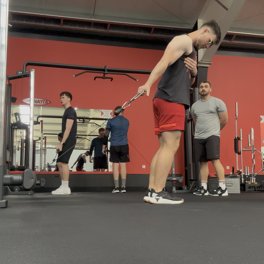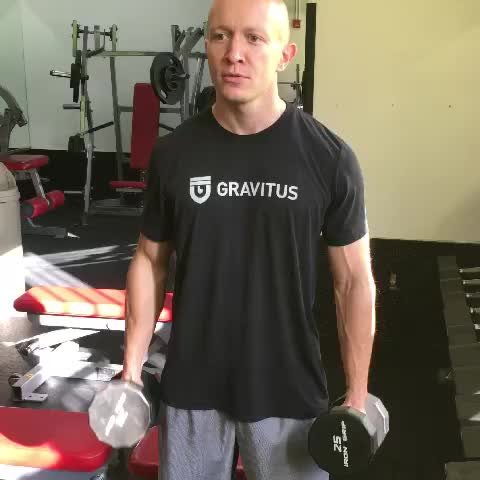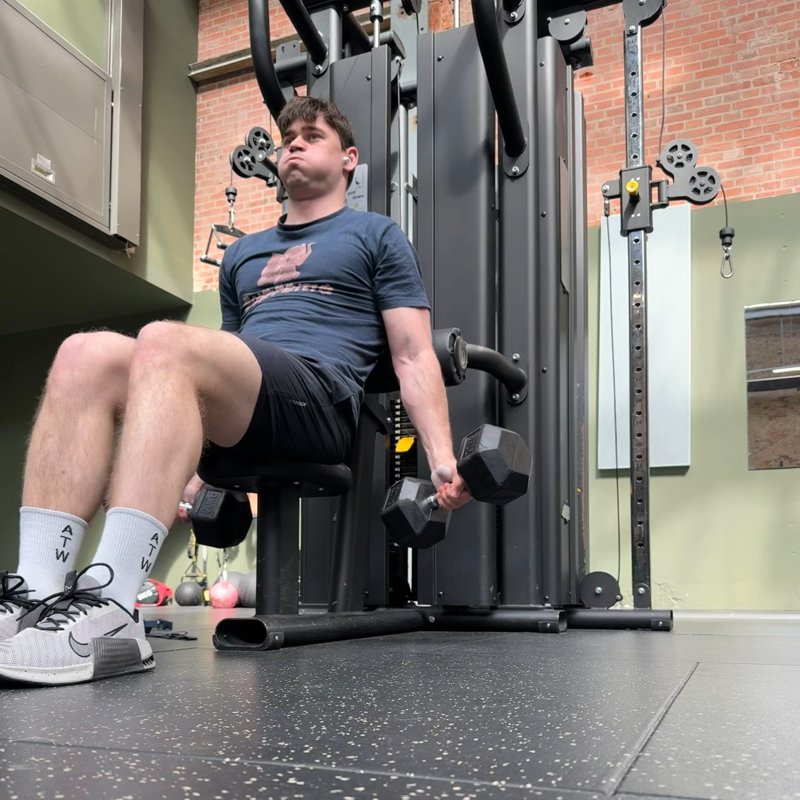Bayesian Cable Curl: The Ultimate Guide
The Bayesian Cable Curl is a specialized bicep exercise performed using a cable machine that emphasizes constant tension throughout the full range of motion to maximize bicep recruitment and growth.

Quick Facts
Key Benefit
Maximizes bicep tension through optimal positioning and full range of motion
Primary Muscles
Biceps, Brachialis
Secondary Muscles
Abdominals, Anterior Deltoids, Forearms
Equipment
cable machine
Difficulty
Intermediate
Type
Strength
In This Guide
Ready to master the Bayesian Cable Curl?
Track your progress, see improvements over time, and build strength consistently.
Download GravitusThe Bayesian Cable Curl represents an evolution in bicep training methodology, applying biomechanical principles to maximize muscle fiber recruitment and growth stimulus. Named for its evidence-based approach to muscle development, this exercise variation optimizes the traditional cable curl by emphasizing proper positioning, controlled tempo, and constant tension to target the biceps brachii more effectively.
Unlike traditional barbell or dumbbell curls where tension varies throughout the range of motion, the Bayesian Cable Curl leverages the constant resistance provided by cable machines. By carefully positioning the body and controlling movement mechanics, this exercise maintains optimal tension on the biceps through the entire range of motion—including the often-neglected stretched position at the bottom of the movement.
What makes the Bayesian Cable Curl particularly valuable is its focus on maximizing time under tension while minimizing joint stress. By eliminating momentum and emphasizing controlled eccentric phases, this exercise creates substantial growth stimulus without excessive loading that might lead to elbow or wrist discomfort. Whether your goal is competitive bodybuilding, improved arm aesthetics, or functional strength development, this scientifically-informed approach to bicep training offers an efficient path to results.
Benefits of the Bayesian Cable Curl
The Bayesian Cable Curl delivers several advantages over traditional bicep exercises through its mechanics and execution principles.
Constant Tension
Unlike barbell or dumbbell curls where tension diminishes at certain points, the cable system maintains consistent resistance throughout the entire movement, enhancing muscle fiber recruitment.
Peak Contraction Enhancement
The positioning and cable angle allows for an intensified contraction at the top of the movement, creating greater stimulation in the muscle's shortened position.
Reduced Joint Stress
The controlled nature of the exercise and the cable's consistent resistance curve minimizes the extreme loading patterns that can stress elbows and wrists during heavy free-weight curls.
Improved Mind-Muscle Connection
The deliberate execution speed and positioning fosters stronger neuromuscular engagement, allowing for better isolation and conscious control of the biceps.
Eccentric Emphasis
The controlled lowering phase exploits the muscle-building potential of eccentric (negative) contractions, which research shows may contribute significantly to hypertrophy.
Customizable Resistance Curve
By adjusting your distance from the cable machine and body positioning, you can modify the resistance pattern to address specific weaknesses in your bicep development.
Proper Form & Technique
Setup
- Attach a straight bar or rope handle to a cable machine set at the lowest position.
- Stand facing the cable machine with feet shoulder-width apart about 1-2 feet away from the pulley.
- Grasp the attachment with an underhand grip (palms facing up) for the straight bar, or with a neutral grip (palms facing each other) if using a rope.
- Position your elbows close to your torso and slightly in front of your body—not directly at your sides.
- Set your shoulders back and down, with chest slightly elevated and core engaged.
- Establish a slight forward lean from the hips (approximately 5-10 degrees) to optimize bicep engagement.
Concentric Phase (Curling Up)
- Initiate the movement by contracting your biceps, not by moving your shoulders or elbows.
- Curl the weight upward in a controlled manner (2-3 second concentric phase) while keeping your upper arms relatively stationary.
- As the handle approaches your shoulders, focus on maximizing the contraction in your biceps.
- At the top position, your forearms should be almost vertical, with wrists neutral (not excessively flexed or extended).
- Briefly hold and squeeze the peak contraction for 1-2 seconds, focusing on maximum bicep engagement.
Eccentric Phase (Lowering)
- Lower the weight in a deliberate, controlled manner, taking 3-4 seconds for the complete eccentric phase.
- Resist the weight throughout the entire lowering portion—never let gravity take over.
- Maintain tension in your biceps even as your arms extend, avoiding complete relaxation at the bottom.
- Stop just before your elbows reach full extension to maintain tension on the biceps.
- Without pausing at the bottom, immediately begin the next repetition, maintaining continuous tension.
Key Form Tips
Cable Position
Ensure the cable remains perpendicular to your forearms at the midpoint of the curl for optimal resistance curve.
Elbow Placement
Keep elbows slightly in front of your torso rather than pinned to your sides to optimize bicep engagement.
Wrist Position
Maintain neutral wrists throughout the movement—avoid excessive flexion or extension that can reduce bicep activation.
Tempo Control
Follow a deliberate tempo (e.g., 213 – 2 seconds up, 1 second squeeze, 3 seconds down) to maximize time under tension.
Body Stability
Minimize body movement—slight forward lean is acceptable, but avoid rocking or using momentum to move the weight.
Range of Motion
Work through the fullest range of motion possible while maintaining continuous tension on the biceps.
Muscles Worked
Primary Muscles
- biceps: The two-headed muscle on the front of your upper arm is the primary target, with both the long (outer) and short (inner) heads being engaged throughout the movement to flex the elbow and supinate the forearm.
- Brachialis: Located underneath the biceps brachii, this muscle is heavily involved in elbow flexion regardless of forearm rotation and contributes significantly to arm thickness when developed.
Secondary Muscles
- brachioradialis: This forearm muscle assists in elbow flexion and receives moderate activation, particularly when using a rope attachment with a neutral grip.
- anterior deltoids: The front part of the shoulder muscle functions as a stabilizer during the movement, preventing excessive shoulder motion when performed correctly.
- forearms: The muscles of the inner forearm assist in maintaining grip and wrist position throughout the exercise, receiving indirect stimulus.
- abdominals: The abdominals, obliques, and lower back work isometrically to maintain proper body positioning and resist momentum during the exercise.
Common Mistakes and How to Fix Them
Using Excessive Body Momentum
Swinging the torso or using shoulder movement to lift the weight reduces bicep activation and defeats the purpose of the exercise. Fix by using a lighter weight that allows for strict form, focusing on initiating the movement from the biceps only. Consider performing the exercise with your back against a wall or with one hand on your hip for body awareness.
Improper Elbow Positioning
Keeping elbows pinned tightly against the sides or allowing them to drift too far forward/outward changes the muscle recruitment pattern. Maintain elbows slightly in front of the torso throughout the movement. A good visual cue is to imagine holding a small foam ball between each elbow and the corresponding side of your torso—not so tight that it's crushed, but not so loose that it would fall.
Insufficient Range of Motion
Not extending arms sufficiently at the bottom or not curling fully at the top limits muscle fiber recruitment and growth stimulus. Focus on feeling a gentle stretch in the biceps at the bottom (without fully locking out the elbows) and achieving complete contraction at the top. Use mirror feedback or video recording to assess your range of motion if unsure.
Incorrect Wrist Position
Excessively flexing or extending the wrists shifts tension away from the biceps and can cause wrist discomfort. Keep wrists in a neutral position aligned with your forearms throughout the movement. Imagine your hands as simple hooks connecting you to the handle—they shouldn't bend significantly in either direction.
Inconsistent Tempo
Rushing through repetitions, particularly the eccentric (lowering) phase, reduces time under tension and diminishes results. Implement a deliberate tempo—for example, 2 seconds up, 1 second squeeze at the top, 3-4 seconds down. Using a metronome app or counting mentally can help maintain disciplined timing until it becomes habitual.
Inappropriate Resistance Level
Using too much weight causes form breakdown; too little provides insufficient stimulus. Select a weight that allows you to perform 8-12 controlled repetitions with proper form, where the last 2-3 reps challenge you without requiring momentum or form compromises. Be willing to adjust the weight as needed if you notice technique deteriorating.
Exercise Variations
Grip Variations
-

Straight Bar Bayesian Cable Curl
The standard version using a straight bar attachment with an underhand (supinated) grip, maximizing overall bicep recruitment with emphasis on the inner head.
-

EZ-Bar Bayesian Cable Curl
Utilizing an EZ-bar attachment that places the wrists in a more neutral position, potentially reducing wrist strain while still effectively targeting the biceps.
-

Rope Bayesian Cable Curl
Performed with a rope attachment using a neutral grip (palms facing each other), which increases brachialis and brachioradialis engagement while reducing stress on the wrists and elbows.
-

Wide-Grip Bayesian Cable Curl
Taking a wider grip on the straight bar to emphasize the inner (short) head of the biceps, creating a different stimulus for balanced development.
-

Narrow-Grip Bayesian Cable Curl
Using a closer hand position on the straight bar to increase emphasis on the outer (long) head of the biceps, helping to develop the coveted bicep peak.
Positioning Variations
-

Kneeling Bayesian Cable Curl
Performed in a kneeling position to eliminate potential lower body involvement and increase stability, allowing for greater focus on bicep isolation.
-

High-Angle Bayesian Cable Curl
Standing farther away from the cable pulley to create a more upward angle of pull, increasing tension at the stretched position of the movement.
-
Single Arm Bayesian Cable Curl
Executing the movement one arm at a time using a single handle attachment, allowing for complete focus on each side individually while addressing potential muscle imbalances.
-

Incline Bench Bayesian Cable Curl
Performing the curl while seated on an incline bench with the back support, placing the biceps in a pre-stretched position for increased range of motion and tension.
Intensity Techniques
-

Bayesian Cable 21s
Breaking the range of motion into segments—7 repetitions in the lower half, 7 in the upper half, and 7 through the full range—to increase time under tension and create comprehensive stimulus.
-

Bayesian Cable Drop Set
Performing a set to near failure, then immediately reducing the weight by 25-30% and continuing until reaching secondary failure, potentially enhancing metabolic stress and growth stimulus.
-

Bayesian Cable Iso-Dynamic Set
Incorporating strategic isometric holds at various points in the range of motion between dynamic repetitions to increase time under tension and neural drive.
Frequently Asked Questions
The Bayesian Cable Curl differs from standard cable curls in several key aspects. First, it emphasizes specific positioning—with elbows slightly forward rather than at the sides—to optimize the resistance curve and muscle fiber recruitment. Second, it implements deliberate tempo control with particular attention to the eccentric (lowering) phase, typically taking 3-4 seconds compared to the often-rushed lowering in traditional curls. Third, it focuses on maintaining constant tension throughout the movement, avoiding both complete lockout at the bottom and rest at the top of the motion. The Bayesian approach also places greater emphasis on the mind-muscle connection, encouraging conscious control of the biceps rather than simply moving weight from point A to point B. These methodological differences are based on scientific principles of muscle growth optimization, hence the "Bayesian" name referencing evidence-based training.
Most trainees benefit from including Bayesian Cable Curls 1-3 times per week, depending on their overall training split and recovery capacity. Beginners might start with once weekly as part of a comprehensive arm training day, focusing on mastering the technique before increasing frequency. Intermediate lifters often do well with twice weekly sessions, perhaps as part of an arm-specific day and again as a secondary exercise on a pull-focused day. Advanced trainees might implement the exercise up to three times weekly, varying the intensity, volume, and specific variations across different sessions. Regardless of frequency, pay attention to recovery signals—persistent bicep soreness, decreased performance, or joint discomfort indicates a need for additional recovery time. Remember that the biceps also receive significant indirect work during compound pulling exercises like rows and pull-ups, which should be factored into your overall arm training volume.
The ideal rep range for Bayesian Cable Curls depends on your specific goals, but most trainees see optimal hypertrophy results in the 8-12 repetition range with appropriate weight selection. The methodical nature of the exercise, with its emphasis on controlled tempo and constant tension, makes lower rep ranges (1-5) less suitable for most trainees. For pure hypertrophy purposes, occasionally extending into the 12-15 rep range with very strict form can provide additional metabolic stress and time under tension benefits. Advanced trainees might benefit from strategically cycling between different rep ranges—for example, 4 weeks focusing on 10-12 reps, 2 weeks pushing into the 15-20 rep range for metabolic work, then 2-3 weeks in the 6-8 rep range for relative strength development. Regardless of the rep range chosen, the final 2-3 repetitions should challenge you significantly while still allowing maintenance of proper form and tempo.
While the Bayesian Cable Curl is an excellent exercise, relying exclusively on any single movement for bicep development may limit your results. Different exercises create unique stress patterns and activation sequences that collectively provide more comprehensive development than any single movement alone. That said, the Bayesian Cable Curl could certainly serve as your primary bicep exercise for a training phase of 4-8 weeks, potentially rotating between its various grip and position variations to maintain novelty. For optimal development, consider a program that includes the Bayesian Cable Curl as a cornerstone movement, supplemented with other bicep exercises that offer different resistance profiles (like dumbbell curls for their increasing resistance curve) or stability requirements (like barbell curls for their free-weight properties). The principle of variation suggests that strategic rotation between different bicep exercises throughout your training cycle will likely yield better long-term results than exclusive reliance on any single movement.
Yes, the Bayesian Cable Curl can be appropriate for beginners, though some modifications may be helpful. The cable machine's consistent resistance and the exercise's controlled nature actually make it safer than some free-weight alternatives. Beginners should start with lighter weights to master the technique, potentially using a mirror for visual feedback on form. The emphasis on controlled movement and mind-muscle connection makes this an excellent foundational exercise for those new to resistance training. That said, complete novices might benefit from first developing basic movement patterns and coordination through simpler exercises before progressing to the more technique-focused Bayesian approach. If you're new to resistance training, consider working with a qualified trainer for your first few sessions to ensure proper setup and execution. Once the basic movement pattern is established, the Bayesian Cable Curl offers an excellent platform for progressive development without the coordination challenges that some free-weight exercises present.
Video Demonstrations

Log in to watch video demonstrations
Login to Watch2 video demonstrations available
Track your progress with Gravitus
Download Gravitus to log your workouts, track your progress, and join a community of fitness enthusiasts.

Helpful Resources
One Rep Max Calculator
Find your one rep max for any exercise without maximal testing. Essential for developing effective strength training programs.
Calculate 1RMWorkout Programs
Follow structured workout programs created by fitness professionals to maximize your strength and muscle gains.
View Programs




